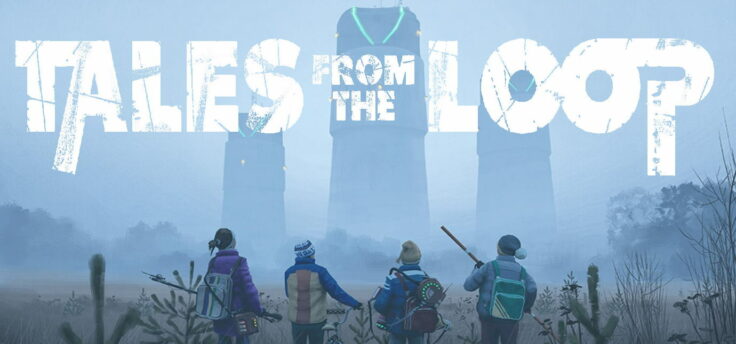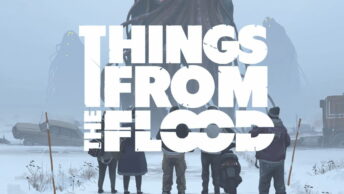The The Famous Five meets X-files in the 80’s
Free League
Genre: Tabletop RPG
Developer: Free League Publishing
Publisher: Free League Publishing
Release date: March 10, 2017


You’ve probably seen the at least something made by Simon Stålenhag at this point. His art combines the mundanity of 80’s and 90’s living with the fantastical and often show scenes that would be pretty normal, were it not for a robot standing in the snow, a huge gravity defying airship flying past in the distance or a dinosaur standing in front of an ice cream truck. His art is both beautiful and eerie at the same time.
Tales from the Loop is an RPG based on his art. In it you’re playing children who are growing up in an alternative 80’s, an 80’s that would seem familiar to us, were it not for the giant airships and the robots (and other things). Michael Jackson was still popular, kids still played D&D and Call of Cthulhu and the C64 could be found in many homes, but if you look out the window you might see a massive barge fly by, and nobody will think that’s odd. It’s an investigation focused game where the kids need to solve mysteries as the adults are too out of touch, out of reach or too blind to see what’s going on.

The Setting
Tales from the Loop is set in an 80’s that’s strikingly similar to our 80’s. If you were lucky enough to be able to tune into MTV on the 1st of August 1981 you would have heard the hit song Video Killed the Radio Star by The Buggles, geeky kids got their first programming experience in early home computers like the C64 and the ZX spectrum shows like He-man and Transformers would have tried to convince kids to nag their parents to buy overpriced pieces of plastic.
But the world of the loop is not quite like ours. The so called Magnetrine Effect was discovered in the 40’s and with it airships could be built that used the earth’s magnetic field to fly. These airships could be made far larger and carry more cargo than conventional planes, though they had limitations of their own. In the 60’s scientists in Japan were able to build the first self-balancing robots, and thanks to this bipedal robots soon hit the market. While these proved to have limited military use, they found great success in the civilian field.
During the 60’s two giant particle accelerators were built. The first located in, or rather under, Boulder City in Nevada, not far from the Hoover Dam, and the other under Ekerö Municipality in Sweden, just outside of Stockholm. These two facilities have been running since the late 60’s, and some people claim that weird things are happening around them. Things from the past, and creatures long thought to be extinct somehow show up around these facilities, at least if the rumors are to be believed.
The Swedish loop is run by Riksenergi, a state run agency that’s assumed to be a sister organization to the telecommunications agency. Nobody, apart from those directly involved with Riksenergi truly knows what their role really is though, and what kind of research is being conducted by them. On the US side it’s DART (the department of advanced research into teleportation) that’s responsible for running the loop. What exactly DART is doing is considered top secret, but they have been recruiting many of the top scientists in the US. Also, how involved the US was with the Swedish loop is still an open question, as Sweden, with its small population, would have had a hard time financing such a project.

The many fantastical elements in Tales from the Loop are considered normal in the setting. A kid might still be fascinated by a bipedal robot walking by the same way as a kid today might be fascinated by a train or an airplane, but for most people it’s really nothing special, they are so used to seeing these things. Some of the side effects of the loop(s) are a bit different though, and not necessarily normal, but other than that the fantastical is treated as something mundane.
The core rulebook for Tales from the Loop gives an introduction to what life in the 80’s would have been like, what music and games were popular and also a description of the area around the two sites, Ekerö Municipality in Sweden and Boulder City in the US. It’s not an in-depth description, but should be enough to at least get a general idea of what the different places were like.
With the side effect of the loop (and other things scientists have been able to create) a GM really has a lot of room for creativity when running Tales from the Loop. Pretty much anything is within the realms of possibilities, be it robots becoming fully sentient, people from the past suddenly showing up in the present or portals opening up that leads to faraway places. But so much freedom might be overwhelming for some GMs. Luckily the book does come with a few plot hooks and four adventures that show a bunch of different things that can happen in the world and that can act as inspiration.
The Rules
Tales from the Loop uses a simplified version of the Year Zero engine, seen in most other Free League games. This is the most rules-light incarnation of the rulesystem yet, and there are very few rules to keep track of during play.

The Year Zero engine is a dice pool system where whenever you need to perform a task that requires a skill check you add together your attribute and skill value, roll that many six-sided dice and any die that comes up a six is a success. In order to succeed with a task you need to roll a certain number of successes, usually one, but sometimes more, and if you fail a skill test you’re allowed to “push” your roll by re-rolling any die that did not come up a six. Pushing a roll does give your character a negative condition though, even if it succeeds. Roll more than the necessary number of successes and you can add a positive effect, relevant to the skill that was just rolled.
A character in Tales from the Loop does not die, they’re kids after all, but they can suffer conditions. Whenever something bad happens to them, they take a relevant condition, of which there are four different ones. Upset, injured, scared and exhausted. Every condition will subtract one die from any future rolls until it’s healed, and if a character ever takes five conditions they’re considered “broken” and can’t do much more until they’ve had some time to recover.
The rules are easy to work with, but it’s not a ruleset where everything is strictly codified, like in say Pathfinder or Dungeons & Dragons, instead they require the GM and the players to use their best judgment to determine what’s fair and when it’s appropriate to make a skill check.
The Characters
Every player character in Tales from the Loop is a kid, age 10-15. Once they turn 16 they’re considered too old for this game and are retired. There is a followup game called Thing from the Flood that’s set in the 90’s where you play as teenagers that the character could be migrated to, as the rules are really similar. There’s no official support for it in either core rulebook, but it’s easy enough to do.

Like in other Year Zero Engine games there’s a soft class system being used that determines what your character is good at. In Tales from the Loop your “class” determines how high you can raise certain skills at character creation, but otherwise it does not have a big impact on the rules part of the game. The classes are typical schoolyard archetypes, things a kid might be called by their peers, like Bookworm, Jock, Troublemaker and Weirdo. Each one has three different “key skills” that can be raised higher than the rest during character creation. The computer geek for an example has the skills Calculate, Program and Comprehend as their key skills.
A characters age will determine their attributes. The older the character, the higher the attributes, but younger characters do instead get more “luck”. Luck points lets you re-roll dice, so while an older character might be more capable in general, a younger character has a better chance of succeeding when it really matters.
Kids also have iconic items. These are special items that they have available that can help them in different situations. The iconic items are usually common items like calculators, skateboards or such, but for the kid they’re special and when they’re trying to do something where the item can logically be used (say they need to chase someone they can use their skateboard) they get two bonus dice. They also have a “pride”, something they’re proud of or that drives them. This can, once per session, be used to automatically succeed on a roll, but only if the pride is relevant to the situation. Both iconic items and pride are up to the players to decide, and there’s no strict rules limitations for them, though the GM can of course say if they think the things are fine or not.
Kids also have relationships with the other kids, some might be friends, others friendly rivals and so on. They also have a hideout together, some place where they can meet, away from the grownups. These things mostly exist to add more flavour to the characters.
Over time they also do learn new things. After each session or adventure experience is handed out, and for five experience points a skill can be increased by one. This is not really a game where mechanical growth of the characters is emphasized though, and there’s nothing else to spend those experience points on other than skills.
Character customization is in other words pretty slim, but that fits the game. Tales from the Loop is after all a pretty rules light game about kids investigating strange things, not tactical combat, and having a lot of different weird abilities would probably take away from the feeling of playing as ordinary kids.
The Adventures
Tales from the Loop  comes with a short campaign consisting of four linked adventures that take place over the course of a year, either near the Swedish or the US site. The adventures can be played standalone, but they’re really at their best when played in order. Each one, apart from the last, is pretty short though, and can realistically be finished in 2 sessions (the book claims that they’re 1 session adventures, but that is, in my experience, slightly optimistic, unless you’re running marathon sessions). The final adventure is about twice as long as the first three. And while the game is about kids, the adventures are not entirely “kid friendly”.
comes with a short campaign consisting of four linked adventures that take place over the course of a year, either near the Swedish or the US site. The adventures can be played standalone, but they’re really at their best when played in order. Each one, apart from the last, is pretty short though, and can realistically be finished in 2 sessions (the book claims that they’re 1 session adventures, but that is, in my experience, slightly optimistic, unless you’re running marathon sessions). The final adventure is about twice as long as the first three. And while the game is about kids, the adventures are not entirely “kid friendly”.
The adventures make for a pretty good introduction to the setting and what you can expect from it, but more importantly they give ideas for what kind of adventures fits the game. The first adventure also does a good job at introducing a new GM to how you can run a pre-written adventure, though the new GM tips are presented in a non-intrusive way, so an experience GM can easily skip them.
Art, Layout & Quality
As you would probably expect from a game based on someone’s artwork, the art in Tales from the Loop is stunningly beautiful and there’s plenty of it in the book. This is then helped further by the excellent print quality.
It is for the most part easy to find what you’re looking for in the book, and most rules are roughly where you would expect them to be, though the large pictures and the airy layout does mean that there can be a fare bit of page flipping needed to get to the right page. As the game is so rules light there’s probably not going to be any real need to flip through the book much during play.
The book itself feels sturdy and the binding is solid. It’s hard to say how well it will last over a long period of time, but it does at least feel like a quality book that won’t fall to pieces anytime soon. The paper is also quite thick and is unlikely to rip unless you’re being extremely carless. Overall the quality of the book is outstanding.
Closing Thoughts
Tales from the Loop is a great RPG that feels different from most other RPGs on the market. As the players are playing children the kind of problems they’ll have to solve are different from what you would usually find in an RPG, and the setting gives GMs a lot of room to come up with their own crazy adventures. One adventure the kids might be trying to stop a mad scientist who has built a machine that’s able to control all the cars on the island, in another the kids need to find out how the loop has been able to summon a wooly mammoth and in a third they need to figure out if their teacher has been replaced by a robot. It’s an RPG that works very well for episodic adventures, that are only loosely connected, as it’s written with the assumption that the adults will never really know what’s going on, and the kids are still ultimately kids living normal lives and doing ordinary things most of the time, and the juxtaposition between the mundane and the fantastic is an important part of the setting.
It is an RPG that might be tough getting into if you’re coming from RPGs focusing on tactical combat and where the rules provide a lot of guidance. It requires a different mindset than most other RPGs, even most other investigation focused ones. And despite the first adventure in the mini-campaign giving a good introduction to how to run an adventure, Tales from the Loop is probably not the best game for a brand new GM. But if you think the concept sounds interesting and you don’t mind the rules taking a backseat then Tales from the Loop comes highly recommended.










